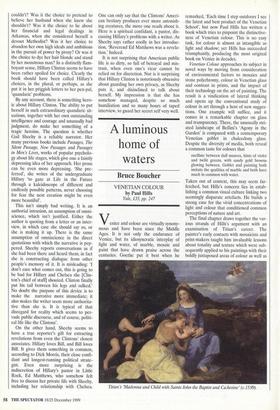A luminous home of waters
Bruce Boucher
VENETIAN COLOUR by Paul Hills Yale, 135, pp. 247 Venice and colour are virtually synony- mous and have been since the Middle Ages. It is not only the endurance of Venice, but its idiosyncratic interplay of light and water, of marble, mosaic and paint that have drawn praise across the centuries. Goethe put it best when he
remarked, 'Each time I step outdoors I see the latest and best product of the Venetian School', but now Paul Hills has written a book which tries to pinpoint the distinctive- ness of Venetian colour. This is no easy task, for colour is almost as intangible as light and shadow; yet Hills has succeeded triumphantly, producing the most original book on Venice in decades.
Venetian Colour approaches its subject in novel ways by moving from consideration of environmental factors to mosaics and stone polychromy, colour in Venetian glass and contrast in prints, and the impact of their technology on the art of painting. The result is a vindication of lateral thinking and opens up the conventional study of colour in art through a host of new sugges- tions. One example will suffice, and it comes in a remarkable chapter on glass and transparency. There, the unusually stri- ated landscape of Bellini's 'Agony in the Garden' is compared with a contemporary Venetian goblet in chalcedony glass. Despite the diversity of media, both reveal a common taste for colours that
oscillate between dull mauves, hints of violet and twilit greens, with sandy gold browns glowing between. Goblet and painting both imitate the qualities of marble and both have much in common with water.
Taken out of context, this may seem far- fetched, but Hills's concern lies in estab- lishing a common visual culture linking two seemingly disparate artefacts. He builds a strong case for the vivid concentrations of light and colour that conditioned common perceptions of nature and art.
The final chapter draws together the var- ious strands of Hills's argument with an examination of Titian's career. The painter's early contacts with mosaicists and print-makers taught him invaluable lessons about tonality and texture which were sub- sequently applied to his paintings with their boldly juxtaposed areas of colour as well as Titian's 'Madonna and (laid with Saints John the Baptist and Catherine' (c.1530). in his use of brushstroke to evoke form and contour. The line of thought here, like that of fhe book as a whole, is highly stimulating and largely convincing, and whatever quib- bles might be raised, readers of this book will appreciate the hard thinking and look- ing behind its every sentence.























































































































 Previous page
Previous page